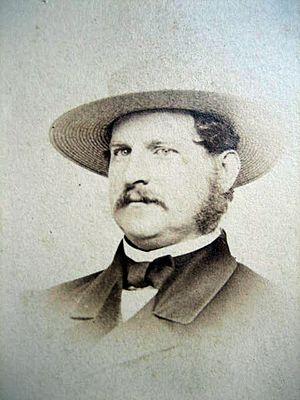Peter A. Porter (colonel) facts for kids
Quick facts for kids
Col. Peter A. Porter
|
|
|---|---|
 |
|
| Member of the New York Assembly for Niagara County | |
| In office January 1, 1862 – December 31, 1862 |
|
| Preceded by | Oliver P. Scovell |
| Succeeded by | William Morgan |
| Personal details | |
| Born |
Peter Augustus Porter
July 14, 1827 Black Rock, New York |
| Died | June 3, 1864 (aged 36) Cold Harbor, Virginia |
| Resting place | Oakwood Cemetery Niagara Falls, New York |
| Political party | War Democrat |
| Spouses |
Mary Cabell Breckinridge
(m. 1852; died 1854)Josephine Matilda Morris
(m. 1859) |
| Relations | See Breckinridge family |
| Children | 3, including Peter |
| Parents | Peter Buell Porter Letitia Breckinridge |
| Alma mater | Harvard College Harvard Law School |
| Profession | Lawyer, politician, soldier |
| Military service | |
| Branch/service | |
| Years of service | 1862–1864 |
| Rank | Colonel |
| Battles/wars | U.S. Civil War • Battle of Spotsylvania • Battle of Cold Harbor |
Peter Augustus Porter (born July 14, 1827 – died June 3, 1864) was an important American figure. He was a lawyer, a politician, and a brave soldier. He served as a colonel in the Union Army during the American Civil War. Sadly, he died fighting in the Battle of Cold Harbor.
Contents
Early Life and Education
Peter Augustus Porter was born on July 14, 1827, in Black Rock, New York. His father, Peter Buell Porter, was a lawyer and a military leader. He even served as the United States Secretary of War. His mother was Letitia Breckinridge. Peter had a half-brother, John Breckinridge Grayson, from his mother's first marriage. He also had a younger sister, Elizabeth Lewis Porter.
Peter went to Harvard College and later studied in Germany at Heidelberg and Berlin. He then graduated from Harvard Law School in 1857. Besides his studies, he also enjoyed writing plays, poems, and essays.
His Famous Family
Peter came from a well-known family. His grandfather, John Breckinridge, was a U.S. Senator from Kentucky. He also served as the United States Attorney General under President Thomas Jefferson.
His first cousin was John C. Breckinridge, who became the youngest-ever Vice President of the United States. He served from 1857 to 1861.
On his father's side, his grandfather, Colonel Joshua Porter, was a Yale College graduate. He was a hero in the American Revolutionary War, fighting in important battles like the Battle of Saratoga. After the war, his grandfather was elected to various public jobs for 48 years!
Public Service and the Civil War
In 1862, Peter Porter was elected to the New York State Assembly. He represented Niagara County as a "War Democrat," which meant he supported the Union during the Civil War.
Joining the War Effort
The Civil War was a difficult time for many families. Peter's half-brother, John Breckinridge Grayson, joined the Confederate States Army and became a general. Sadly, John died in October 1861 from illness.
Peter decided to join the Union Army. On July 7, 1862, he became a Colonel of the 129th New York State Volunteers. This group later became the 8th New York Heavy Artillery Regiment. His regiment was stationed around Washington, D.C., helping to protect the capital. They also trained to fight as infantry soldiers if needed.
In September 1863, Peter was asked to run for Secretary of State of New York. But he refused. He said that his neighbors had trusted him to lead their sons in the war, and he couldn't leave them. This shows how dedicated he was to his soldiers.
A Close Call and a Final Battle
In May 1864, during a break in the Battle of Spotsylvania, a Confederate soldier tried to shoot Peter. The soldier had been a prisoner under Peter's command before. Peter's men quickly shot the soldier, who was badly hurt. Even then, the soldier said he wished he had killed Peter. Peter stopped his men from hurting the soldier further.
On June 3, 1864, during the fierce Battle of Cold Harbor in Virginia, Peter's commanding general was wounded. Peter bravely took command of the brigade and led a charge. He was shot through the neck. He tried to keep going, but fell a few steps later.
That night, five of his brave men, including Sergeant Le Roy Williams, risked their lives to bring Peter's body back to the Union side. They carried him through a rainstorm, even though he had six bullets in him. Sergeant Williams later received the Medal of Honor for his courage.
Peter's body was first taken to Baltimore, Maryland, then to St. Peter's Episcopal Church in Niagara Falls, New York. He was honored with his country's flag draped over him.
Personal Life
In 1852, Peter married his cousin, Mary Cabell Breckinridge. Her father was a Presbyterian Minister and a chaplain for the U.S. House of Representatives. Peter and Mary had one son:
- Peter Augustus Porter (1853–1925), who later became a member of the United States House of Representatives.
Sadly, Mary died in 1854 during a cholera epidemic.
On November 9, 1859, Peter married Josephine Matilda Morris. They moved into a new house in Niagara Falls. Together, they had two children:
- Letitia Porter (1861–1864), who died of diphtheria just five months after her father.
- George Morris Porter (1863–1907).
Peter's funeral was held at St. Peter's Episcopal Church in Niagara Falls. He was buried in Oakwood Cemetery.
See also
- Breckinridge family

